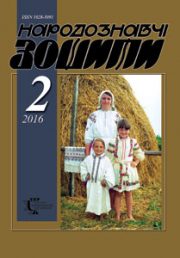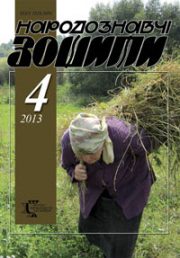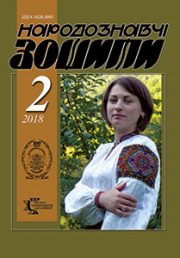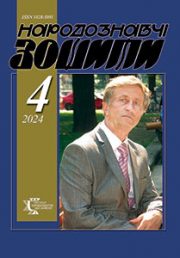The Ethnology Notebooks. 2019, 1 (145), 113—119
UDK 929 КОРПАНЮК+7.03:745.51(477)(092)
DOI https://doi.org/10.15407/nz2019.01.113
BILYJ Victor
ORCID ID: http://orcid.org/000-0002-7107-4862
Candidate of Art (Ph. D), associate professor
Kosiv Institute of Applied and Decorative Art
Lviv national academy of arts,
Department of Fine Art and Academic Disciplines
2, Adam Mitskevych str., 78601,
Kosiv, Ivano-Frankivsk region, Ukraine
Contacts: e-mail: biluy61@meta.ua
Abstract. Petro Korpaniuk is the representative of the local carvers of Shkriblyak-Korpaniuk dynasty, which started new trends in the decoration of wood items, determined the basic principles of their artistic decoration, identified the main ornamental motifs, various combinations of which have become characteristic of this carving center. Problem Statement. P. Korpaniuk as a representative of younger craftsman generation on the one hand continue traditions of the glorious family, on the other hand stay in constantly searching for new artistic expressiveness ways, coherent contemporaneity. Paper goal: the characterization of craftsman creative handwriting, who, based on the Kosiv carving tradition, suggests his own interpretation of the form, proportions, techniques and ornamental motifs. Methods. The main study methods of craftsman works were become comparative-historical and structural. The first one allowed revealing the traditional decorations, which are typical for Kosiv carving. The second one was used in the works analysis, taking into account the stability of the links between elements in the integral system which is an work of art. Results, Conclusion. P. Korpaniuk suggests his own vision of Kosiv woodcarving tradition with using flat carving, inlaid colored wood, pearl and metal based on rich family inheritance. The craftsman builds his compositions on contrastive comparisons of patterned stripes with incomplete space, rectilinear and rounded motifs, and versatile planes.
Keywords: Kosiv, carving, craftsman, ornament, motif, dynasty.
Received 5.02.2019
REFERENCES
Bilyj, V. (2010). Formuvannia indyvidualnoho styliu v tvorchosti narodnykh maistriv khudozhnoi obrobky dereva (na prykladi rizbarskykh dynastii Shkribliakiv ta Korpaniukiv). Folklore and Ethnology, 4, 105—109 [in Ukrainian].
Budzan, A. F. (1960). Rizba po derevu v Zakhidnykh oblastiakh Ukrainy. Kyiv: Vyd-vo AN URSR [in Ukrainian].
Zakharchuk-Chuhai, R.V. (1979). Rodyna Shkribliakiv: albom. Kyiv: Mystetstvo [in Ukrainian].
Klymenko, O. (2002). Narodnyi maister yak tvorcha osobystist (Do problemy indyvidualnoho v narodnomu mystetstvi). Tradytsiine y osobystisne v mystetstvi: Kolektyvne doslidzhennia za materialamy Chetvertykh Honcharivskykh chytan. Kyiv: UTsNK Muzei Ivana Honchara [in Ukrainian].
Kuryluch, М. (2001), & L.M. Dovha (Ed.). Hutsulskyi ornament. Kyiv: LK Mejker [in Ukrainian].
Selivachov, M.R. (2002). Yurii Shkribliak i yoho vnesok u rozvytok ukrainskoho obrazotvorchoho mystetstva. Folklore and Ethnology, 5, 59—65 [in Ukrainian].
Solomchenko, O.H. (1979). Suchasni khudozhni promysly Prykarpattia. Kyiv: Znannia [in Ukrainian].
Stankevych, M.Ya. (2002). Ukrainske khudozhnie derevo. Lviv: Afisha [in Ukrainian].
V.H. Bilozubov, P.H. Yurchenko, A.F. Budzan, & P.M. Zholtovskyi (Eds.). (1962). Ukrainske narodne mystetstvo: rizblennia ta khudozhnii metal. Kyiv: Derzhavne vydavnytstvo obrazotvorchoho mystetstva i muzychnoi literatury URSR [in Ukrainian].
H.H. Pudyk (Ed.). (1974). Yurii ta Semen Korpaniuky. Kyiv: Mystectvo [in Ukrainian].
Yusypchuk, Yu.V. (2016). Vasyl Devdiuk — maister hutsulskoho rizblennia ta metalirstva. Ivano-Frankivsk: Misto-NV [in Ukrainian].
Jaremin, Ja. (2018) Petro Korpaniuk Exhibition of Wood Carving Opened in Kosiv. Retrieved from: http://huculia.info/petro-korpanyuk-exhibition-museum-kosiv/ (Last accessed: 11.09.2018) [in Ukrainian].







